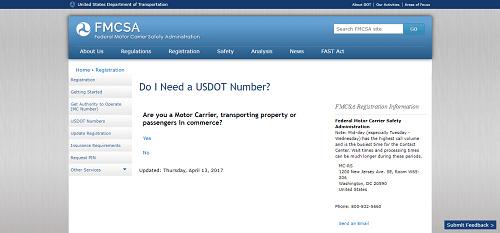Whether you oversee a fleet or your company owns vehicles that regularly take part in interstate commerce, it’s important that you are in-the-know about the ins and outs of the USDOT number system. When compared to other FMCSA guidelines, it’s relatively straightforward, but it still takes some time and dedication to ensure that your vehicles and drivers are on the right side of the strict compliance regulations enforced by the association.
A USDOT number is a unique identifier that is given to companies that engage in interstate, and in some cases, intrastate, commerce. It aids in monitoring to streamline safety compliance and is used when conducting official audits, reviews, and accident investigations. The number itself is granted by the Federal Motor Carrier Safety Administration (FMCSA).
To ensure that your fleet is operating legally, you must first determine whether or not you need to register with the FMCSA to obtain a USDOT number. It is the responsibility of the motor carrier operator or driver to know their USDOT numbers, so make sure that you equip your employees/contractors with the right registration information before you send them on the road.

Screenshot via FMCSA
There are a few ways to determine if you need a USDOT number, but the simplest is to visit the FMCSA’s website. There, you will find an interactive quiz that asks a series of questions about your vehicle(s) and your business. Once completed, the administration will give you an answer as to whether or not you will need to register.
If you’d prefer, you can also read the FMCSA’s official guidelines to confirm that you are compliant. You must register your vehicle with the agency and obtain a USDOT number if:
OR
AND is involved in interstate commerce (in this case, interstate commerce is defined as “trade, traffic, or transportation in the United States”):
Another quick way to determine USDOT number compliance is to take a quick look at the list of states that require the special registration code. Here are the current states that demand that the specified vehicles obtain the number for intrastate commerce:
If the state(s) in which you operate is not listed above, it doesn’t mean that you aren’t necessarily off-the-hook when it comes to complying to similar regulations. Always be sure to check with your state’s intrastate commerce regulations before you activate your fleet.

As stated, determining whether or not a USDOT number is necessary is a relatively straightforward process, but there are a few challenges associated with the procedure:
Obtaining USDOT numbers is an important part of operating a safe fleet that complies perfectly with all state and federal regulations. Do the proper work that it takes to guarantee that yours will be granted with no extra stress or delays.
Our sales engineers are experts in automatic asset tracking, tagging and identification,a nd can answer all your questions. Get in touch now.
Lets Talk ›